#jebel qatrani formation
Explore tagged Tumblr posts
Text

Fossil Novembirb: Day 15
A Goliathia eats a lungfish while a Nycticorax sp. watches
30 notes
·
View notes
Text
Very late on this one but I think theres some cool stuff to talk about.
I actually covered this formation extensively a few years ago when giving the Wikipedia page a major overhaul at the request of someone on discord, so the research phase for Josch was mercifully easy (at least for me, not so much for those making the reference size chart).
Really one of the main things that the research focused on was which localities to choose. For reference, Jebel Qatrani spans the Eocene-Oligocene boundry and has localities representing different time intervalls. For example, locality L-41, which is the single most specious, was deposited during the Late Eocene, localities A and B right after the boundry and localities I and M are among the most recent. After some debating I and M kinda cristalized into the main ones to use, they are pretty close together so the fauna was likely to overlapp a good deal, they had some iconic animals and they also preserve a bulk of the bird fauna, which really helped fill lots of the space to not overcrowd with mammals.
Obviously my personal highlight was the featured crocodilian, Eogavialis africanum. Right out of the gate its an interesting one. Traditionally, Eogavialis, like other closely related forms (informally "thoracosaurs") have been recovered as some type of gharial, generally closer to Indian Gharials than Tomistoma (in old phylogenies featuring Tomi as a crocodylid, thoracosaurs are still deemed gharials proper).
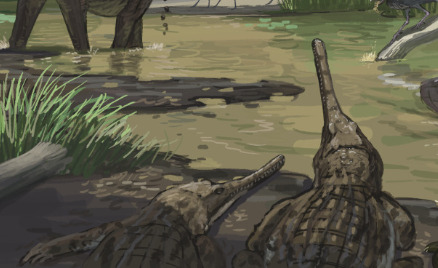
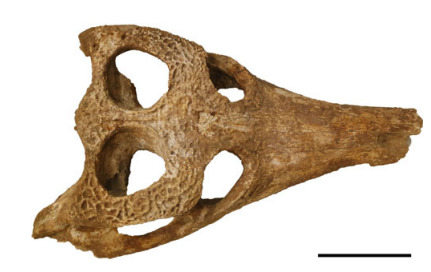
Now I initially had like three whole paragraphs typed on why I don't think this is the case, but for brevity's sake I'm going to save that for a future post on thoracosaurs in general (perhaps its something to cover after I'm done with mekosuchines). So for now, just know that tho it could be an early African gharial, its also possible that Eogavialis is a member of a much more ancient, non-crocodilian group of Eusuchians that just happens to look similar to gharials and that went extinct during the Miocene.
Also fun fact, the patterns and colours are based on modern day broad-snouted caimans.

Also while not featured in this piece I wanna give a shout out to "Crocodylus" megarhinus, a more robust crocodilian from the formation. As you can guess from the "", its no longer thought to belong to Crocodylus but is its own, still unnamed genus, interestingly closely related to the enigmatic mekosuchines endemic to Oceania. The size chart below also features Crocodylus articeps, the slender jaws at the very bottom. Though this species was long deemed a juvenile "C." megarhinus, comparisson with actual juveniles of the latter shows this to be obviously false. Alas the holotype has been lost and it is now deemed a nomen dubium.
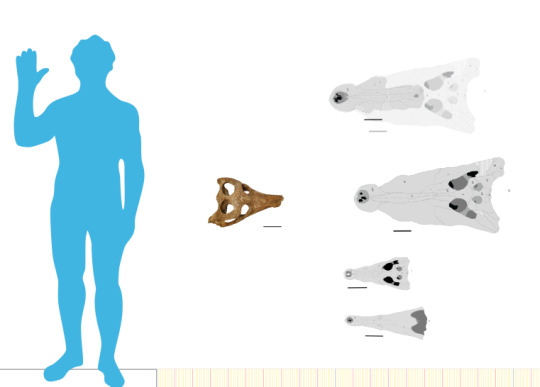
I also wanna give a brief shout out to the bird fauna, which is quite interesting in its own right and features a lot of taxa that match the swampy environment depicted here. For instance there's Palaeoephippiorhynchus, a large stork related to saddle-bills, marabous and jabirus and in a similar size range. There's also Goliathia, a "giant" shoebill. Though, as it turns out, the holotype is smaller than a modern shoebill and one of the referred specimens is only slightly more robust in some ways and not in others. So while interesting, its name (envisioned for what was assumed to be a heron) is not that fitting anymore. Speaking of heron, there is also Xenerodiops, with its uniquely shaped bill. Some researchers have argued that this genus was a type of night heron based on a humerus, though here it is depicted as more generalized given that the humerus and holotype bill have no direct evidence for having belonged to the same animal.
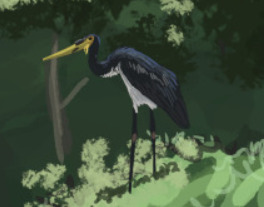
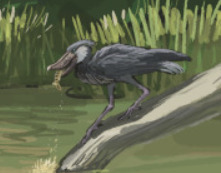
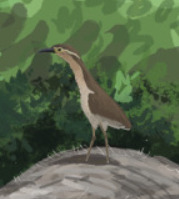
My personal favourites among the birds are the local flamingos and lilly trotters. Flamingo are represented through remains similar to those of Palaelodus (which I talked about in greater detail here and here) and thus likely belonged to that genus or another palaelodid. In short, these birds likely already had a diet not dissimilar to modern flamingos, but lacked the extreme bill curvature. Lilly trotters are better known from the formation and represented some of the earliest records of this family. Three species in two genera have been named, with this one in particular being Janipes, here depicted similar to a pheasant-tailed jacana, which is closely related to at least one of the two Jebel Qatrani jacanas (Nupharanassa specifically). It's been noted that all jacanas from this formation are larger than their modern kin.
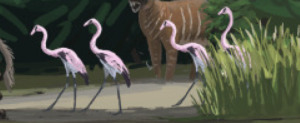

Obviously theres a lot more cool stuff about the formation, including the incredible diversity of hyraxes, the presence of the weird ptolemaiids, three different elephants, the bizarre Arsinoitherium, early sirenians (really this place was a hot spot for afrotheres) and a vast number of primates. But all this goes beyond what I'm most familiar with.
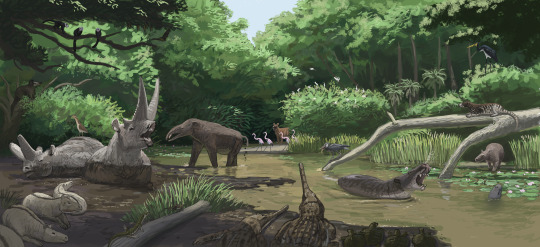
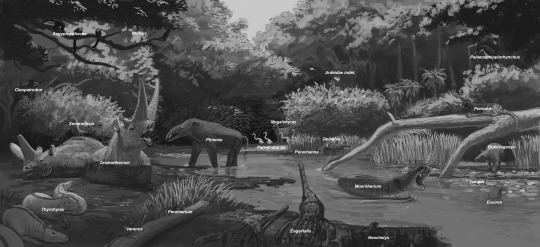
Results from the Jebel Qatrani formation #paleostream!
Arsinoitherium might be the most iconic animal from here but that doesn't make the rest of the fauna less interesting!
#jebel qatrani formation#gebel qatrani formation#fayum#egypt#paleontology#palaeoblr#long post#xenerodiops#palaelodus#janipes#jacana#flamingo#crocodylus megarhinus#eogavialis#eogavialis africanum#thoracosaur#croc#crocodile#gharial#eusuchia#oligocene#prehistory#goliathia#shoebill#paleostream
401 notes
·
View notes
Text

Xenerodiops mycter was an unusual heron from the Oligocene (~30 million years ago) of what is now Egypt.
Known only from a partial skull and an arm bone, it's estimated to have stood around 70cm tall (~2'4") and was probably fairly similar in overall appearance to modern night herons. Its beak was powerfully built and had a distinctive downwards curve, shaped more like some types of stork than other herons – suggesting it may have had a convergently stork-like lifestyle, slowly walking through its marshy habitat probing around for prey and snapping up whatever its beak came into contact with.
———
NixIllustration.com | Tumblr | Patreon
References:
Dickson, Meig. "Xenerodiops mycter." A Dinosaur A Day, 7 Jul. 2019, https://a-dinosaur-a-day.com/post/186367090025/xenerodiops-mycter
Mlíkovský, Jiří. "Early Miocene birds of Djebel Zelten, Libya." Časopis Národního muzea, Řada přírodovědná 172.1-4 (2003): 114-120. https://publikace.nm.cz/en/periodicals/jotnmpnhs/172-1-4/early-miocene-birds-of-djebel-zelten-libya
Rasmussen, T.; Olson, S.L. & Simons, E.L. "Fossil birds from the Oligocene Jebel Qatrani formation Fayum Province, Egypt." Smithsonian Contributions for Paleobiology 62 (1987): i-iv, 1–20. http://dx.doi.org/10.5479/si.00810266.62.1
Wikipedia contributors. “Xenerodiops.” Wikipedia, 1 Jan. 2024, https://en.wikipedia.org/wiki/Xenerodiops
#science illustration#paleontology#paleoart#palaeoblr#xenerodiops#ardeidae#heron#pelicaniformes#bird#dinosaur#art
288 notes
·
View notes
Text
if you aren't familiar with a given ecosystem, they're all talked about in depth on Wikipedia by the name I use to refer to them.
pick wisely, this is the start of an Adventure
274 notes
·
View notes
Text
Fossil Novembirb: Day 15 - Oasis in the Desert

During the Late Eocene and Early Oligocene, the environment of Jebel Qatrani formation of Faiyum, Egypt was as lush as you could imagine, with tropical forests, and a vast system of wetlands, lakes and rivers connecting to the warm Tethys Sea. As you would expect, such a place was teeming with birds. The birds living here would have no idea that 30 million years later, the Sahara desert would bury all this greenery. But for now, it is an oasis where birds of a feather flock together.
Goliathia: One of the earliest known relatives of the shoebill, arguably one of the most awesome birds alive today.
Nycticorax: An early member of the modern night-heron genus. It is not named, but can be assigned to the genus thanks to the shape of its limb bones.
Xenerodiops: An early member of the stork family with a short, recurved beak. It probably fed like modern wood storks, probing the water with the beak open, snapping it shut on passing fish.
Nuphranassa: A member of the modern jacana group, but much larger than any living species at about the size of a chicken.
Janipes: Another large jacana. Not as large as Nuphranassa, but still larger than any modern jacana. One must wonder what these guys were walking on.
Palaeoephippiorhynchus: An early stork well known from this period. It closely resembles the saddle-billed and black-necked storks, but was markedly smaller in size.
Eremopezus: A very poorly know flightless palaeognath known from a few fragmentary limb bones. Probably related to modern ostriches.
#Fossil Novembirb#Novembirb#Dinovember#birblr#palaeoblr#Birds#Dinosaurs#Cenozoic Birds#Goliathia#Nycticorax#Xenerodiops#Nuphranassa#Janipes#Palaeoephippiorhynchus#Eremopezus
56 notes
·
View notes
Photo

I guess I'm content having no idea what to do with the environment here, so now that the animals themselves are complete, I'll call this finished and publish it. Here's a pair of Arsinoitherium zitteli having a pretty one-sided argument, in Egypt's Jebel Qatrani formation Digtal Painting (Photopea) 2021
#Arsinoitherium#finished piece#digital painting#Photopea#Jebel Qatrani formation#Egyptian prehistory#Paleoart#paleoillustration#Christopher Maida Artwork
222 notes
·
View notes
Photo

I guess I'm content having no idea what to do with the environment here, so now that the animals themselves are complete, I'll call this finished and publish it. Here's a pair of Arsinoitherium zitteli having a pretty one-sided argument, in Egypt's Jebel Qatrani formation Digtal Painting (Photopea) 2021
#Arsinoitherium#finished piece#digital painting#Photopea#Jebel Qatrani formation#Egyptian prehistory#Paleoart#Paleoillustration#Christopher Maida Artwork
0 notes
Note
What is the largest volant raptor in the Eocene?
As with the question of the largest Mesozoic flying bird, this is not an easy question to answer given how fragmentary most fossils of flying birds tend to be. However, there is an accipitrid from the Jebel Qatrani Formation in Egypt that appears to be about the size of a bald eagle, known only from a partial tarsometatarsus. That’s likely the largest Eocene raptor that I’m aware of.
1 note
·
View note
Text
Aegyptopithecus
Aegyptopithecus
Aegyptopithecus skull Aegyptopithecus, which means "Egyptian Monkey", from Greek Αίγυπτος (Egypt) and πίθηκος (ape or monkey), is an early fossil anthropoid that predates the divergence between hominoids (apes and humans) and cercopithecoids (Old World monkeys). It is known from a single species, Aegyptopithecus Zeuxis, which lived some 35-33 million years ago in the early part of the Oligocene epoch. It likely resembled modern-day New World monkeys and was about the same size as a modern howler monkey, which is about 56 to 92 cm (22 to 36 in) long. Aegyptopithecus fossils have been found primarily in modern-day Egypt. Aegyptopithecus is believed to be a stem-catarrhine, a crucial link between Eocene and Miocene fossils. Aegyptopithecus zeuxis has become one of the best known extinct primates based on craniodental and postcranial remains. Discovery and taxonomy Aegyptopithecus was discovered by E. Simons in 1965 in the Jebel Qatrani Formation in the Fayum Province of Egypt. There is controversy over whether or not Aegyptopithecus should be a genus on its own or whether it should be moved into the genus Propliopithecus. If Aegyptopithecus is placed in its own genus, then there is one documented species named A. Zeuxis. The type specimen for the species is CGM26901. Its scientific name means "linking Egyptian ape". Morphology Aegyptopithecus zeuxis was a species that had a dental formula of 2:1:2:3 on both the upper and lower jaws, with the lower molars increasing in size posteriorly. The molars showed an adaptation called compartmentalizing shear, which is where the cutting edges involved in the buccal phase serve to surround basins in such a way that food is cut into fragments that are trapped and then ground during the lingual phase. The canines of this species were sexually dimorphic. The ascending mandibular ramus of this species is relatively broad. The orbits are dorsally oriented and relatively small which suggested that this was a diurnal species. This species showed some postorbital constriction. The interorbital distance of Aegyptopithecus Zeuxis is large much like that found in colobines. A sagittal crest developed in older individuals and extends over the brow ridges. This species had an auditory region which is similar to that found in platyrrhines, having no bony tube and the tympanic fused to the lateral surface of the bulla. The humerus has a head which faces posteriorly and is narrower than primates that practice suspensory behavior. The humerus also shares some features with extinct hominoids: a large medial epicondyle and a comparatively wide trochlea. This species had an ulna that compares to the extinct members of the genus Alouatta. On the foot bones, this species had a grasping hallux. Aegyptopithecus zeuxis shares characteristics with haplorrhines such as a fused mandibular and frontal symphyses, postorbital closure, and superior and inferior transverse tori. Based on dental dimensions and femoral remains the body mass of A. zeuxis is estimated to be 6.708 kg. The functional length of the femur is estimated to be 150 mm, which is larger than Cebus apella and smaller than Alouatta seniculus. In Egypt’s Fayum Depression a subadult female cranium, CGM 85785, was discovered by Rajeev Patnaik. This specimen’s cranial capacity was found to be 14.63 cm3 and reanalysis of a male endocast (CGM 40237) estimates a cranial capacity of 21.8 cm3. These estimates dispel earlier ones of approximately 30 cm3. These measurements, give an estimated male to the female endocranial ratio of approximately 1.5, indicating A. Zeuxis to be a dimorphic species. The olfactory bulb to endocranial volume ratio is considered to be on the lower end of the strepsirrhine spectrum, perhaps as a result of the organism’s rostrum. In relation to other anthropoids, the frontal lobes of A. Zeuxis are considered to be rather small but the olfactory bulbs are not considered to be small when taking into account the body size of A. zeuxis. Overall, the brain to body weight ratio of A. zeuxis is considered to be strepsirrhine-like and perhaps even non-primate like. Behavior A. zeuxis is thought to have been sexually dimorphic. Tooth size, craniofacial morphology, brain size, and body mass all indicate this. Due to A. zeuxis being sexually dimorphic, the social structure is thought to have been polygynous with intense competition for females. Three femoral remains were found in Quarry I (DPC 5262 and 8709) and Quarry M (DPC 2480). Paleomagnetic dating puts the sites at 33 Ma, consistent with the Oligocene epoch. Based on estimated femoral neck angle (120-130 degrees) of aforementioned remains, the femur is similar to that of a quadrupedal anthropoid. The greater trochanter’s morphology is inconsistent with that of leaping primates, serving as further evidence of the animal’s quadrupedalism. Aegyptopithecus is thought to have been an arboreal quadruped due to the distal articular region of the femur, which is deeper than that of “later” catarrhines. Also, based on overall femoral morphology, A. zeuxis is thought to have been robust. The phalanges of the hands and feet suggest powerful grasping consistent with arboreal quadrupedalism. In conjunction with the femur, the humerus suggests arboreal quadrupedalism. This is based on the pronounced brachialis flange and stabilizing muscles on brachial flexors rather than extensors. In addition, the ulna and distal articular surface of the humerus indicate that A. zeuxis was not only an arboreal quadruped, but also large and slow. This is consistent with evidence extrapolated from femoral morphology. Studies in dental microwear and microsutures focusing on the molars, suggest that Aegyptopithecus was probably a frugivore. It is also possible that Aegyptopithecus ate hard objects on occasion. Habitat Aegyptopithecus lived in the Fayum area of northern Egypt. Today, this area is semiarid and lacking in vegetation. At the time of Aegyptopithecus’ existence, the Oligocene, this area was heavily vegetated, subtropical, had many trees and had seasonal rainfall. source - Wikipedia Dear friends, if you liked our post, please do not forget to share and comment like this. If you want to share your information with us, please send us your post with your name and photo at [email protected]. We will publish your post with your name and photo. thanks for joining us www.rbbox.in
from Blogger https://ift.tt/2l1CfbZ
0 notes
Text
Fossil Novembirb 15: Oasis in the Desert
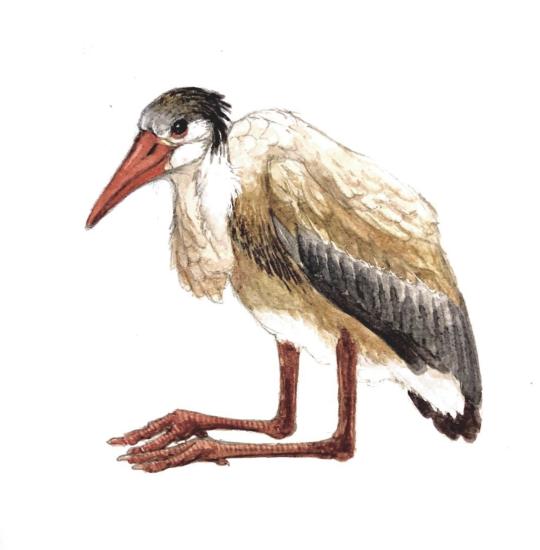
Xenerodiops by @iguanodont
We FINALLY get to an ecosystem that isn't in Europe, North America, Antarctica, or Oceania - it's Jebel Qatrani Time!
(If you are as appalled as I am at the low sampling rates of fossil localities in Asia, South America, and Africa, welcome to the club, and support paleontologists who are from and work in countries from those continents!!!)
The Jebel Qatrani Formation is an ecosystem from Egypt at the end of the Eocene through the early Oligocene. It showcases the tropical forests, swamps, and marshes that existed at this time, emptying into the Tethys Sea. A wet and humid environment, it would have been a weird mixed ecosystem, with both the old and the new coexisting on the riverbanks. And, like in the forests and plains of Oligocene Europe, we see many modern bird groups show up for the first time here - and also very similar to their living relatives! This is a departure from the mammals in the region, which were unique and weird for the time period (though early members of modern groups are found here, too).
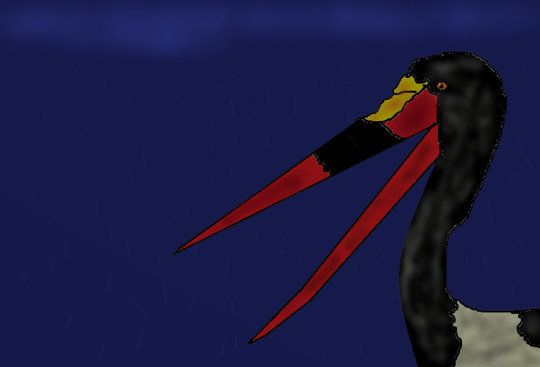
Palaeoephippiorhynchus by Bubblesorg
Being a wetland and humid environment, the main feature of the avifauna here are aquatic birds - many of which have close relatives today. Palaeoephippiorhynchus is the oldest known fossil stork, and was remarkably similar to the living Saddle-Billed Stork - even having the same upcurved bill. While it's uncertain if they're close relatives or not, it is possible that living Saddle-Bills are similar to this ancient form. There was also a mid-sized heron, a bird extremely similar to living Black-Crowned Night Herons, and Xenerodiops - a heron with a pointed and strong bill, curved downward - good for grabbing onto prey. It was a very sturdy, robust bird - even for a heron.
In addition, there was Goliathia - the fossil Shoebill! This bird had legs much like the living shoebill, and was similar enough in the limbs that it might be in the same genus! It probably lived very similarly to living shoebills, feeding on fish in the wetlands around it. What its beak would have looked like is uncertain - the closest living relative to the Shoebill is the Hammerkop, which has a very different skull. What their ancestral skull was, or what Goliathia's was, remains a mystery.

Goliathia by Antonio Rares Mihaila
But if you think I'm done with the water birds, you're very wrong - this is just the beginning! There was also an indeterminant cormorant, which had a very hooked and tapered beak; birds similar to living crowned cranes and others like living flufftails; early jacanas like Janipes which was bigger than all living jacanas but still had the large feet for floating on vegetation, showcasing the vegetation in these wetlands was sturdy enough to hold it up; other early jacanas smaller in size as well like Nupharanassa; and of course -
The Flamingos! Well, yes and no. There was an indeterminate crown-flamingo (ie in the group that all living flamingos are in), a bit bigger than a living lesser flamingo. But there was also Palaelodus - one of the "Grebe-Flamingos" or "Swimming-Flamingos", a long-lasting group of birds that first appear in the early Oligocene and lasted until possibly the Pleistocene! They looked superficially similar to living flamingos and were more closely related to them than to grebes, but they did have some similar characteristics to grebes as well - specifically having less of a kink in the neck, shorter lower legs, and flatter limb bones like those in grebes. They also had webbed feet, which would have allowed for diving or swimming. It also had a straight, conical bill, very unlike the bill of living flamingos.
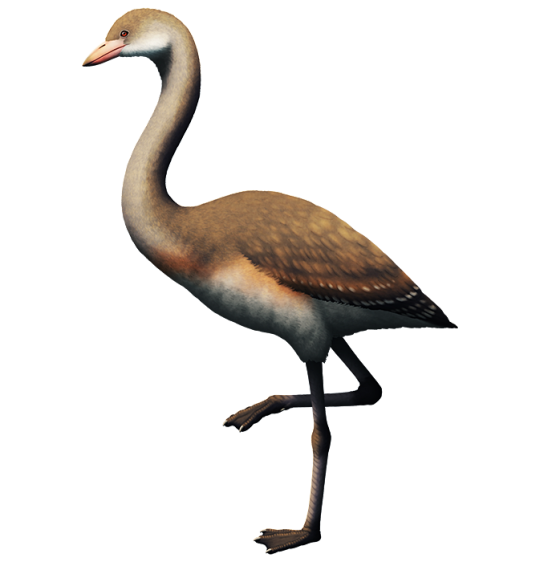
Palaelodus by @alphynix
There were also perching birds, such as an early turaco very similar to the living genus Crinifer; and early eagles, ospreys, and other birds of prey that haven't really been named - mainly because they are very similar to living species, but so distant in time it seems unlikely they'd be in the same genus still... right? One, very similar to the living sea eagle, was found near the shore - indicating a similar ecology to its living relative. Another was almost identical to the living osprey, just smaller in size. And another was similar in size to living ospreys, but more robust than them. This place was filled with raptors!
Of course, I can't ignore the metaphorical elephant in the room. One of the most mysterious birds of the Jebel Qatrani is Eremopezus, a bird that has similarities to so many different groups of birds that its exact position is still a mystery. At this time it is thought to be a Palaeognath, possibly closely related to ostriches or maybe elephant birds - as the volant Lithornithids start to disappear, ratite-like Palaeognaths become more and more common. It was flightless, and probably lived similarly to modern ostriches and other ratites - as a a large herbivore, probably taking advantage of the wetland landscape and the abundance of food.

Eremopezus by @thewoodparable
Jebel Qatrani is such an important formation because it sheds light on the evolution of even more bird groups than those we see in former Laurasia (North America + Eurasia). And it is possible that many lineages we still have in Africa today have been around for thirty million years - and may have been very similar in ecology and appearance during that whole time. Given living birds react to changing climates by shifting with the ecosystems, it's possible that these lines of birds similarly followed the migration of wetlands and other habitats during the climate change to come, persisting to this day across the continent.
Sources:
Kampouridis, P., J. Hartung, F. J. Augustin. 2023. The Eocene-Oligocene Vertebrate Assemblages of the Fayum Depression, Egypt. The Phanerozoic Geology and Natural Resources of Egypt. Advances in Science, Technology, & Innovation. 373-405.
Mayr, 2022. Paleogene Fossil Birds, 2nd Edition. Springer Cham.
Mayr, 2017. Avian Evolution: The Fossil Record of Birds and its Paleobiological Significance (TOPA Topics in Paleobiology). Wiley Blackwell.
Rasmussen, D. T., S. L. Olson, E. L. Simons. 1987. Fossil birds from the Oligocene Jebel Qatrani formation Fayum Province, Egypt. Smithsonian Contributions to Paleobiology 62(62): 1-20.
71 notes
·
View notes
Photo

Landscapes and scenery are not something I do a lot, so I'm not too certain about where this is now. Nevertheless, I hope that the next time I post these Arsinoitherium it will be the finished product.
Digital painting (Photopea)
2021 (in progress)
#Arsinoitherium#Oligocene megafauna#paleoart#paleoillustration#Jebel Qatrani formation#Egyptian prehistory#digital painting#Photopea#landscape#scenery#work in progress#Christopher Maida Artwork
34 notes
·
View notes
Text
Xenerodiops mycter

By Ripley Cook
Etymology: The strangely appearing Heron
First Described By: Rasmussen et al., 1987
Classification: Dinosauromorpha, Dinosauriformes, Dracohors, Dinosauria, Saurischia, Eusaurischia, Theropoda, Neotheropoda, Averostra, Tetanurae, Orionides, Avetheropoda, Coelurosauria, Tyrannoraptora, Maniraptoromorpha, Maniraptoriformes, Maniraptora, Pennaraptora, Paraves, Eumaniraptora, Averaptora, Avialae, Euavialae, Avebrevicauda, Pygostaylia, Ornithothoraces, Euornithes, Ornithuromorpha, Ornithurae, Neornithes, Neognathae, Neoaves, Aequorlitornithes, Ardeae, Aequornithes, Pelecaniformes
Status: Extinct
Time and Place: Between 30.2 and 29.5 million years ago, in the Rupelian of the Oligocene


Xenerodiops is known from the Jebel Qatrani Formation of Egypt
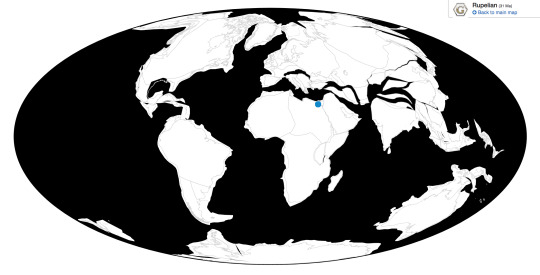
Physical Description: Xenerodiops is a strange intermediate bird, slightly smaller than the smallest living stork - probably no longer than 70 centimeters or so. Still, it was larger than most living species of herons - so this wasn’t a small bird. It was fairly similar to storks too, in terms of the shapes of the known bones, so it seems likely that Xenerodiops was a precursor to that modern dinosaur group. It had a very strong, pointed bill, though, more like herons than storks - adapted for biting and even stabbing prey, rather than snapping up food trapped in vegetation. This weirdly short, heavy bill was also curved downwards, so different from living herons and somewhat similar to living storks. Its wings were heavy and robust, and in general, this was a very sturdy sort of bird.
Diet: Xenerodiops probably fed on animals and, if it is a heron-stork like thing as supposed, it is logical to assume these animals were found in bodies of water.
Behavior: Without more fossils of Xenerodiops, it is difficult to piece together how it would have looked - especially without legs, which would point to whether or not this bird waded in the water as those birds it seems to be closely related to do. Still, for now, that is the simplest explanation for its general lifestyle. Its large beak would have been useful in reaching out into bodies of water and grabbing food sharply, possibly even stabbing it; being curved downwards, it could have been used similar to living stork bills in probing for food in the water. It is possible, then, that Xenerodiops did similar things, going into the water and grabbing as much food with its strong beak as possible, sensing food where it could not see. With its strong, robust wings, Xenerodiops would have been a powerful flier, able to gain a lot of movement from very few flaps of their wings. As with other dinosaurs, Xenerodiops would have probably taken care of its young; whether or not it did so in large colonies or in isolated nests is difficult to tell at this point.

Creatures of the Jebel Qatrani by Stanton F. Fink, CC By-SA 2.5
Ecosystem: The Jebel Qatrani Formation is a fairly famous ecosystem from the Oligocene, a time when the weird creatures of the Eocene and Paleocene were beginning to transition into animals similar to those we see today. In addition to almost-modern forms, of course, there were also the fun offshoots, which is probably where Xenerodiops lies. Jebel Qatrani is famous for its transitional fossils, especially among mammals. It was a thick swamp ecosystem, extremely warm and wet - a tropical wetland, filled with animals taking advantage of the lush plantlife. This place was filled with a variety of mammals - dugong relatives like Eosiren, a transitional primate Aegyptopithecus, a weird pointy heavyset mammal Arsinoitherium, the slightly more hippo-esque but still weird Bothriogenys, giant hyraxes, the lemur-like Plesiopithecus, the false ungulate Herodotius, the strange carnivores Ptolemaia and Qarunavus, a marsupial Peratherium, hyaenodonts like Metapterodon, and an alarming number of rodents. Turtles and crocodilians and other reptiles were plentiful too, like the turtle Albertwoodemys, the crocodile Crocodylus megarhinus, a gharial Eogavialis, and the snake Pterosphenus. As for fish, there were a variety of tetras, snakeheads, and catfish.
Xenerodiops wasn’t the only dinosaur in this environment, either. Many other weird birds were found here, some just as odd and unplaceable as Xenerodiops. For example, Eremopezus lived here - it was some sort of large, flightless bird. Beyond that, we have no idea. There was also the (iconic and large) swimming flamingo, Palaelodus. An even larger sort of shoebill than the living one, Goliathia, prowled the swamps. A giant true stork, Palaeoephippiorhynchus, was a major fixture of the landscape. There were Jacanas like Nuphranassa and Janipes, turacos like Crinifer, and even birds of prey. In a lot of ways, therefore, the birds of the area were even weirder than the mammals - and Xenerodiops was just one of many.
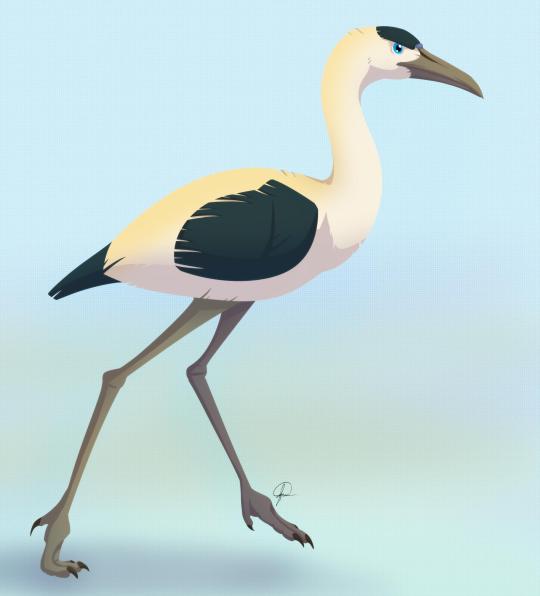
By José Carlos Cortés
Other: What exactly Xenerodiops is remains a mystery. Its weird combination of characteristics points to it being in the group of dinosaurs including a large number of living water birds - and both storks and herons. However, research has shown that storks and herons are actually somewhat removed from each other, with herons being more closely related to pelicans, shoebills, ibises, and even boobies than to storks. Is Xenerodiops, then, a weird, transitional, extinct member of this group of dinosaurs? Is it another evolutionary experiment altogether, with traits of many members of this group? Something else entirely? Only more fossils will help us to make the picture clearer. Some of these traits are shared in other weird waterbirds of the Paleogene (such as Mangystania), and it is entirely possible that there is an extinct clade of these animals, separate from all living members of the group.
~ By Meig Dickson
Sources under the Cut
Mayr, G. 2009. Paleogene Fossil Birds. Springer-Verlag Berlin Heidelberg.
Mayr, G. 2017. Avian Evolution: The Fossil Record of Birds and its Paleobiological Significance. Topics in Paleobiology, Wiley Blackwell. West Sussex.
Mlíkovský, Jiří (2003), "Early Miocene Birds of Djebel Zelten, Libya" (PDF), Časopis Národního muzea, Řada přírodovědná, 172 (1–4): 114–120.
Rasmussen, D. T., S. L. Olson, E. L. Simons. 1987. Fossil Birds from the Oligocene Jebel Qatrani Formation Fayum Province, Egypt. Smithsonian Contributions to Paleobiology 62: 1 - 19.
Zvonov, E. A., N. V. Zelenkov, I. G. Danilov. 2015. A New unusual waterbird (Aves, ?Suliformes) from the Eocene of Kazakhstan. Journal of Vertebrate Paleontology: e1035783.
#Xenerodiops mycter#Xenerodiops#Dinosaur#Aequorlitornithian#Bird#Birds#Ardeaen#Factfile#Dinosaurs#Birblr#Palaeoblr#Carnivore#Water Wednesday#Africa#Paleogene#paleontology#prehistory#prehistoric life#biology#a dinosaur a day#a-dinosaur-a-day#dinosaur of the day#dinosaur-of-the-day#science#nature
219 notes
·
View notes
Text
Eremopezus eocaenus

By José Carlos Cortés on @quetzalcuetzpalin-art
PLEASE SUPPORT US ON PATREON. EACH and EVERY DONATION helps to keep this blog running! Any amount, even ONE DOLLAR is APPRECIATED! IF YOU ENJOY THIS CONTENT, please CONSIDER DONATING!
Name: Eremopezus eocaenus
Status: Extinct
First Described: 1904
Described By: Andrews
Classification: Dinosauria, Theropoda, Neotheropoda, Averostra, Tetanurae, Orionides, Avetheropoda, Coelurosauria, Tyrannoraptora, Maniraptoriformes, Maniraptora, Pennaraptora, Paraves, Eumaniraptora, Averaptora, Avialae, Euavialae, Avebrevicauda, Pygostylia, Ornithothoraces, Euornithes, Ornithuromorpha, Ornithurae, Neornithes, Palaeognathae, Eremopezidae
What is Eremopezus? A mystery. It is probably from the Jebel Qatrani Formation of Egypt, living about 30.2 - 29.5 million years ago, in the Rupelian age of the Oligocene of the Paleogene (it was once thought that this formation dated to the Eocene, but it has since been re-dated). This formation is notable for the significant number of transitional mammal and bird forms - between the early members of groups known from the Eocene and the close to modern forms from the Neogene. Eremopezus is mysterious both for its age - which makes finding its phylogenetic affinities more difficult than if it were, say, younger and more similar to modern forms - and its incompleteness - it is only known from very limited material of the leg, discovered in two batches, one at the beginning of the 1900s and the other more recently. It was originally considered to be a ratite - but it may, in fact, not be a ratite at all. Eremopezus has a lot of traits that actually aren’t found in ratites at all, but are unique or found in other birds (ie, the Neognaths - the group containing literally all other birds). In fact, it has similar traits to modern Secretarybirds and Shoebill, which are both from Africa as well (though it’s probably not related to either). Still, recent analyses have grouped it with the Elephant Birds - but the jury remains out.

By Jack Wood on @thewoodparable
It is entirely possible that Eremopezus is actually its own distinct lineage of ratite - since almost all ratites evolved flightlessness independently (apart from emu and cassowary which are very closely related), Since most ancestors of ratites and modern ratites are mainly known from recent fossil records, this marks a very early experiment in ratite-like body plan and lifestyle amongst Palaeognaths (given that most large flightless birds of the Paleogene were actually from other bird groups - see Gastornis and the early Terror Birds and Bathornithids). This would also make it a very unique and convergent sort of Paleognath, having evolved traits similar to other bird groups independently. Eremopezus was probably about the size of a modern large rhea or small emu, though it had very robust foot bones that would have been able to support a heavier body than those of the rhea. It probably stood as tall as a person. As such, it probably was flightless, though of course it is difficult to determine that without further fossils and it is possible that it could fly. Its toes flared out from the foot like that of a Cassowary, allowing for the weight to be supported over a larger surface area. The toes would also have been bulkily padded, allowing for the toes to be very flexible and mobile, so it moved around on foot a lot regardless of its flight status and may have used its feet for other activities.

By Scott Reid on @drawingwithdinosaurs
Eremopezus lived in the Jebel Qatrani Formation, an environment of freshwater rivers and shallow low-lying lakes near the Tethys Sea. It was a very tropical environment with monsoon seasons and swamps, and while reed grasses that characterize Egypt today were present, they were much rarer. Many mammals were present including Creodonts and Anthracotheriids, two types of completely extinct mammal lineages that looked like squat felines and elongated hippos respectively; an ancient primate, some shrews and hyraxes and even a marsupial. When it comes to birds, there was a relative of the shoebill, a relative of storks, a relative of herons, as well as cormorants, jacanas, and turacos. There were also crocodilians, gharials, snakes, and turtles. In this environment, it is likely that Eremopezus was some sort of herbivore, even a fruit eater, though without actual fossils of the head or gut contents we can’t know for sure. It may have gone extinct due to habitat turnover as grasses began to spread further in Africa.
Source:
https://en.wikipedia.org/wiki/Eremopezus
https://en.wikipedia.org/wiki/Jebel_Qatrani_Formation
#eremopezus#eremopezus eocaenus#bird#dinosaur#birblr#palaeoblr#paleontology#prehistory#prehistoric life#dinosaurs#biology#a dinosaur a day#a-dinosaur-a-day#dinosaur of the day#dinosaur-of-the-day#science#nature#factfile#Dìneasar#דינוזאור#डायनासोर#ديناصور#ডাইনোসর#risaeðla#ڈایناسور#deinosor#恐龍#恐龙#динозавр#dinosaurio
62 notes
·
View notes
Text


Results from the Jebel Qatrani formation #paleostream!
Arsinoitherium might be the most iconic animal from here but that doesn't make the rest of the fauna less interesting!
#paleoart#sciart#paleostream#palaeoblr#jebel qatrani#egypt#oligocene#arsinoitherium#meoritherium#hyaeonodont#proboscidean#river#forest
401 notes
·
View notes